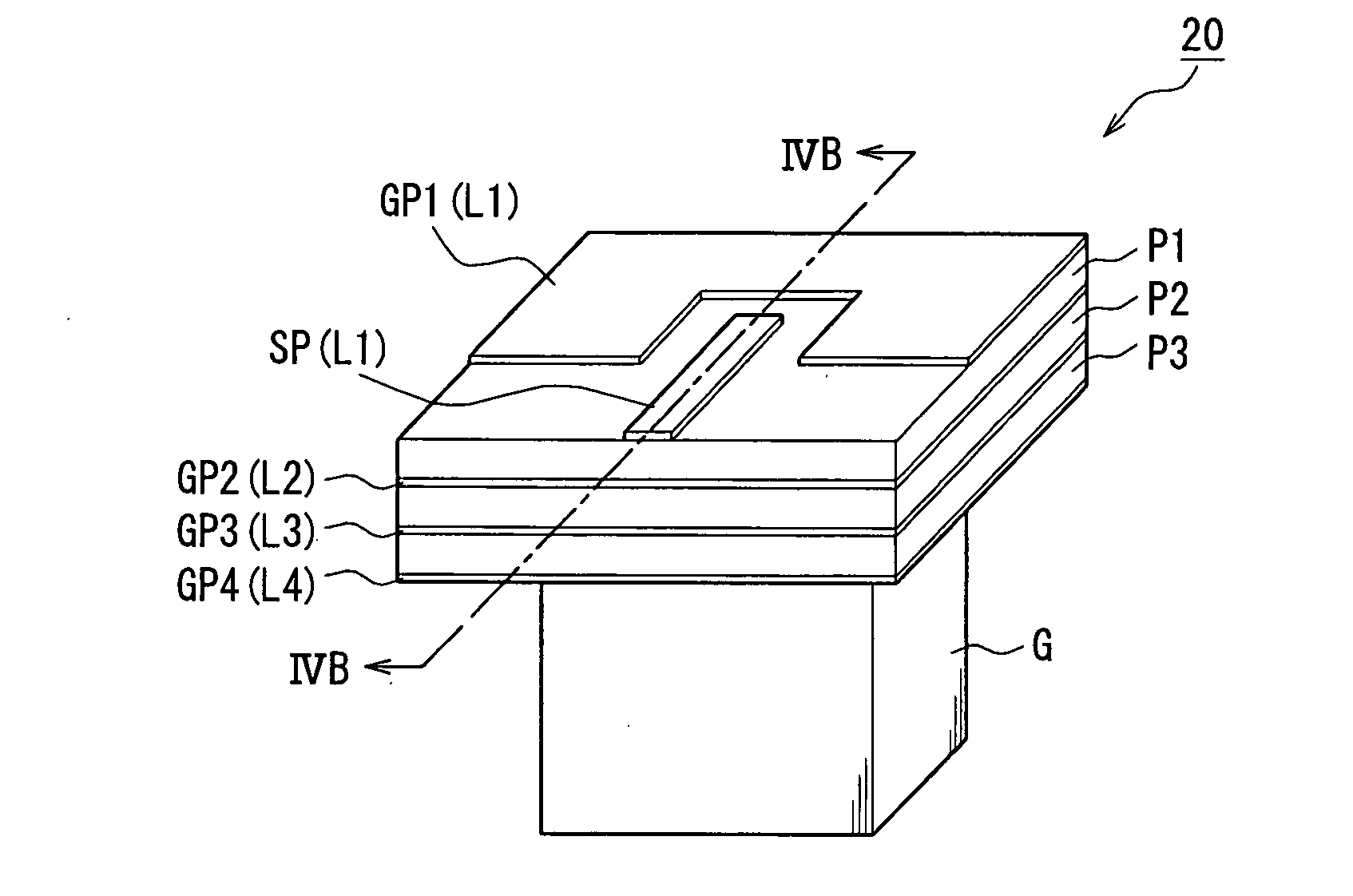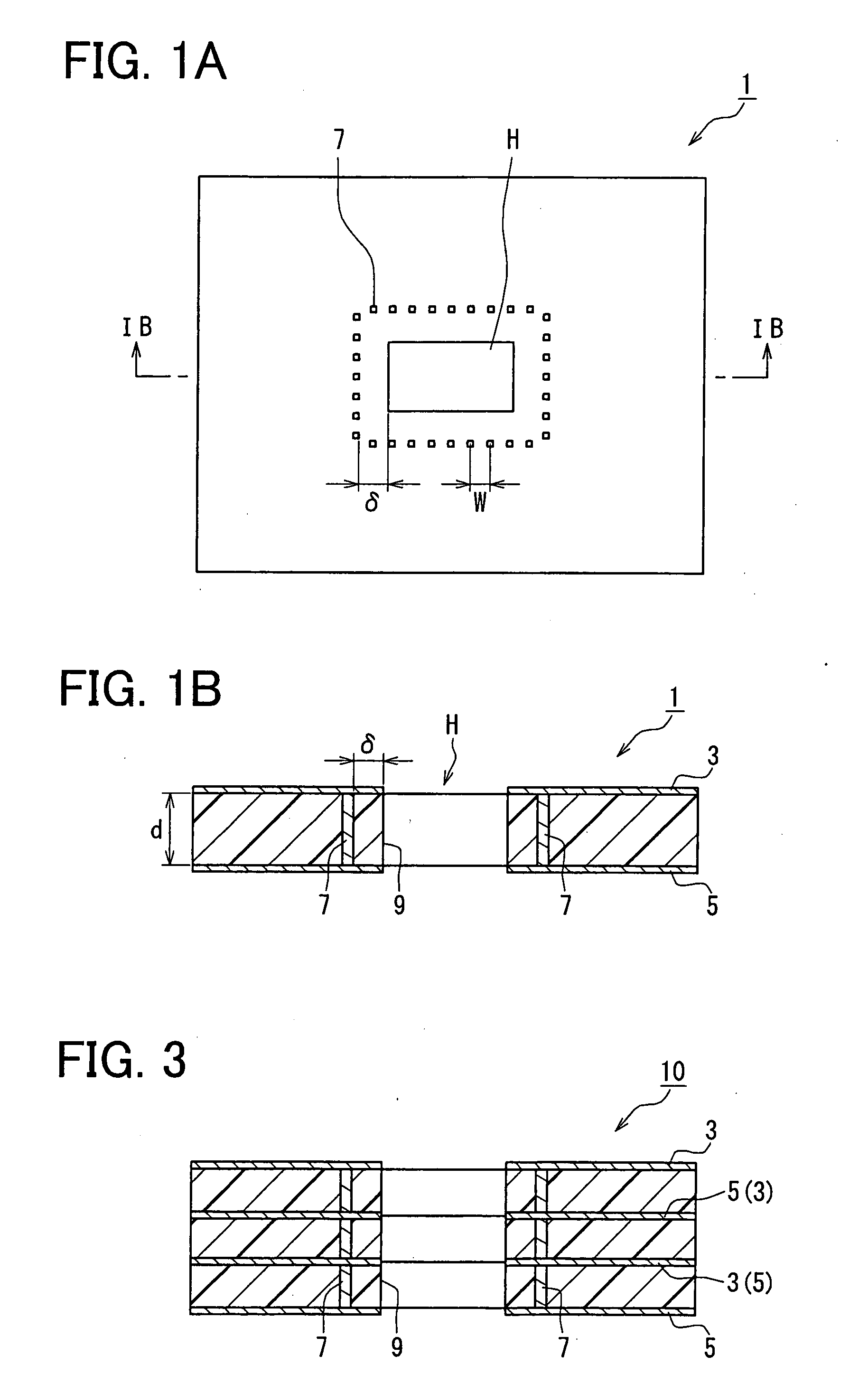Dielectric substrate for wave guide tube and transmission line transition using the same
a technology of waveguide tube and dielectric substrate, which is applied in the direction of electrical equipment, coupling devices, impedence networks, etc., can solve the problems of degrading the performance of the waveguide tube, and achieve good performance and mechanical strength
- Summary
- Abstract
- Description
- Claims
- Application Information
AI Technical Summary
Benefits of technology
Problems solved by technology
Method used
Image
Examples
first embodiment
[0024]A dielectric substrate 1 according to the invention will be described with reference to FIGS. 1A and 1B, FIGS. 2A and 2B and FIG. 3.
[0025]The dielectric substrate 1 has conductive layers 3, 5 respectively formed on the upper and lower surfaces thereof, each of which has a ground pattern, a signal line pattern. The dielectric substrate 1 also has a thickness d (e.g. about 100 μm) and a rectangular hole H whose size (e.g. 2.54 mm×1.27 mm) is substantially the same as the hole of a waveguide tube for transmitting electromagnetic wave of a certain frequency band (e.g. 75-110 GHz).
[0026]Plural via holes 7 are formed at equal intervals W in a belt portion of the dielectric substrate 1 at a distance δ from the wall 9 of the hole H. Assuming that the wave length of the transmission signal is λg, the distance δ is designed to be λg / 2 and the interval W is designed to be less than λg / 4. In case of the frequency of the transmission signal being 76.5 GHz, for example, the distance δ is 0....
second embodiment
[0032]A transmission line transition 20 according to the invention will be described with reference to FIGS. 4A and 4B and FIG. 5A-5D.
[0033]The transmission line transition 20 is constructed of three dielectric substrates P1-P3 and four pattern layers L1-L4 that are interleaved with each other, so that the dielectric substrate P1 and the pattern layers L1, L2 form a line transition section 20a, and so that the dielectric substrates P2, P3 and the pattern layers L2-L4 form a waveguide tube section 20b.
[0034]The transmission line transition 20 has a rectangular cavity 21 that extends along the center axis of the waveguide tube section 20b to be connected to a waveguide tube G, which is fixed to the waveguide tube section 20b. The waveguide tube G has a rectangular hole of 2.54 mm×1.27 mm to transmit an electromagnetic wave of a frequency between 75 GHz and 110 GHz (e.g. 76.5 GHz).
[0035]The waveguide tube section 20b has plural via holes 23 formed in the dielectric substrates P2, P3 a...
third embodiment
[0042]A transmission line transition 30 according to the invention will be described with reference to FIGS. 6A and 6B.
[0043]The transmission line transition 30 is constructed of three dielectric substrates P1-P3 and four pattern layers L1-L4 that are interleaved with each other, so that the dielectric substrate P1 and the pattern layers L1, L2 form a line transition section 30a, and so that the dielectric substrates P2, P3 and the pattern layers L2-L4 form a waveguide tube section 30b. The waveguide tube section 30b is the same as the waveguide tube section 20b of the second embodiment.
[0044]The line transition section 30a is formed of the dielectric substrate P1 and the pattern layers L1 and L2. The pattern layer L2 has a ground pattern GP2 that covers the entire surfaces of the dielectric substrates P1, P2 confronting each other except for the surface inside the via holes 23. The antenna pattern AP, which is disposed at the bottom of the cavity 21 in the second embodiment, is omi...
PUM
 Login to View More
Login to View More Abstract
Description
Claims
Application Information
 Login to View More
Login to View More - R&D
- Intellectual Property
- Life Sciences
- Materials
- Tech Scout
- Unparalleled Data Quality
- Higher Quality Content
- 60% Fewer Hallucinations
Browse by: Latest US Patents, China's latest patents, Technical Efficacy Thesaurus, Application Domain, Technology Topic, Popular Technical Reports.
© 2025 PatSnap. All rights reserved.Legal|Privacy policy|Modern Slavery Act Transparency Statement|Sitemap|About US| Contact US: help@patsnap.com



